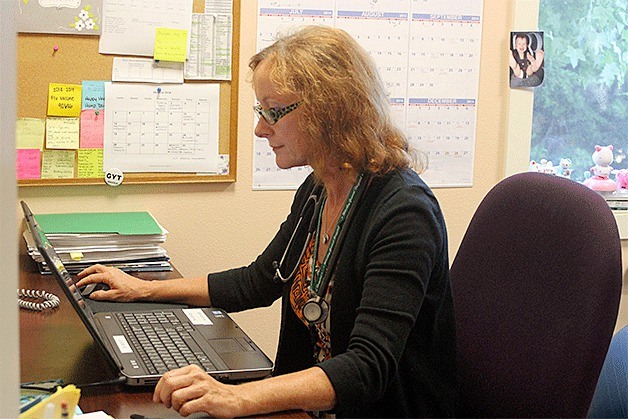For midwife Sarah Meyer, supporting women in the birthing process is a wonderful experience.
Meyer said she loves seeing the transformation of a woman becoming a first-time mother.
“This is life changing for women, particularly having their first baby, and I love to be able to see that transformation,” Meyer said.
Meyer became a registered nurse 30 years ago in New Zealand. Ten years later, she shifted gears to become a midwife.
“I wanted to work in an area that specifically kind of dealt with women’s health,” she said.
Midwives care for women from their first period through the rest of their lives, according to Meyer, not just the well-known obstetric focus.
Eighteen months ago, Meyer partnered with Dr. Robert Burnett and Dr. Melissa Chinn, who specialize in obstetrics and gynecology, at Island Women’s Healthcare Clinic in Coupeville.
The clinic provides complete OBGYN care for women and offers patients a choice between the traditional medical approach or the increasingly popular midwifery approach to care.
Meyer said midwives take care of the majority of childbearing women in many countries all over the world, but “it hasn’t really been mainstream in America.”
She said that lately, many hospitals have started embracing midwifery, just like Whidbey General Hospital has done with the clinic.
Island Women’s Healthcare is the first clinic Meyer has worked in that has both obstetric doctors and a midwife in the same building.
“Midwives always work in collaboration with an obstetrician or gynecologist,” she said.
They do this in case there are any medical complications with a woman’s care.
In the clinic, Meyer said the doctors are “very supportive of midwifery care, and I’m able to consult with them on a daily basis.”
She used to work in a midwifery clinic in Mount Vernon, where she consulted with doctors who didn’t work out of the same building, and she finds having them so close is a lot easier.
“They have a really good idea about my practice, and I think that the trust between providers is really important, so I think it works really well,” she said.
Patients at the clinic get to choose which treatment path they want to follow, and Meyer said that midwifery is good for women wanting a low-intervention birth.
“Midwives really encourage women to actively participate in decision making, to really be involved in their care, along with their families, and so midwives often appeal to women who are really looking for that kind of birth experience.”
Another benefit, according to Meyer, is that once active labor starts, she is able to stay with the mother all throughout the process, whereas obstetricians aren’t able to do so because of other patients and commitments they have to take care of at the same time.
“Midwifery is more of a one-to-one management during labor, where we end up managing more than one patient during labor a lot of times,” Burnett said. “And so we utilize a lot of the labor and delivery nurses to do a lot of the hands-on things during labor.”
Meyer said that if, throughout the pregnancy or labor, there were any high-risk situations or “anything that seemed untoward,” she would refer the patient to the obstetricians.
“We’re there to help with problems she can’t manage or shouldn’t manage,” Burnett said.
However, if the woman were to stay healthy and have no complications, “like most women,” Meyer said she would oversee their care throughout the pregnancy.
“My role is to kind of support and encourage women to have a positive experience with childbirth,” she said.
“I think that you need to deliver with a provider that you feel comfortable with, that is going to support your decisions, and, for some women, that is an obstetrician,” Meyer said. “And for some others, it would be a midwife. I think that having both choices is ideal.”



